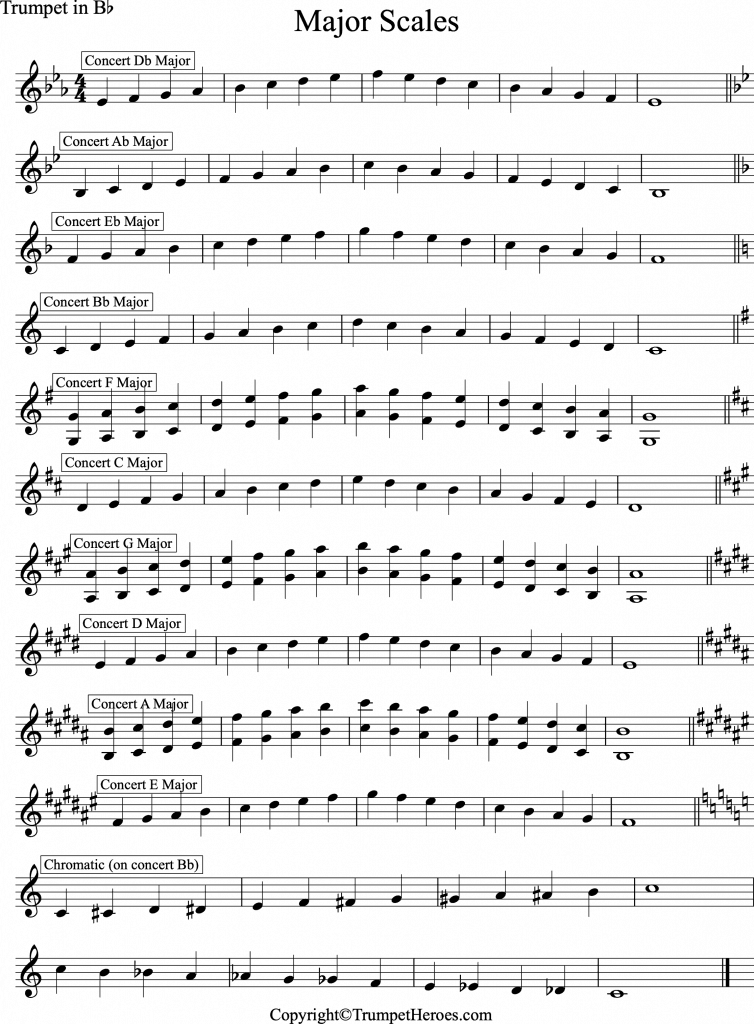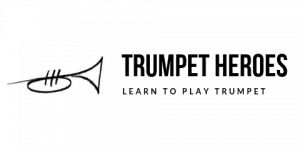Playing scales is important to virtually all musicians, and Trumpet players can take advantage of scales to make them stronger, faster and smarter players. If you are a beginner you should probably focus on getting the Concert Bb scale under your fingers and into your chops. It is on this sheet but there’s a lot of other, more challenging scales as well. Carry on at your own risk.
Since you’re still reading, or at least scanning, you must be interested in the major scale sheet below. Some of the scales appear in 2 octaves, and ideally you would work towards playing both. If a scale goes too high for you to play well and sound good, just skip down the octave for those notes then skip back up on the way down. If a scale goes below your working range it’s time to learn those notes and get them sounding good. I’ve added the next note up in each scale at the top to make the rhythm fit the bars.
Trumpet Major Scales – Scale Sheet
Here is a scale sheet of major trumpet scales that you can download or print:

Find a printable Trumpet Scale Sheet document here:
Bonus Fun Facts About Scales on Trumpet for the Keen Reader.
Scales are referred to by their starting notes. So, the first scale on the sheet is your Eb Major scale. You’ll also see, in a box above each scale, what they are called in the real world (of your band teacher’s mind). If that’s confusing then you haven’t got the business of being a transposing instrument figured out. Try THIS explanation. You’ll have to scroll way down to the heading “Concert Pitch”. Enjoy the pretty pictures.
The major scales above are in order of key signature, so you’ll probably want to start in the middle and work your way out into the sharps and flats. If you haven’t yet learned any music theory you might want to take note of those key signatures and how they relate to the starting notes (tonics). Some of these keys might seem unlikely to appear in your Concert Band, but if you play in a group with string players or singers you’re going to need them.
A Few Pointers on Playing Trumpet Scales
Listen as you play. If it doesn’t sound like the old “Doe, a deer, a female deer” kind of Do Re Mi major scale then you’re missing something.
Trumpet minor scales will be added if there is a lot of activity on the Major Scales.
A Chromatic scale is pretty much playing the fingering chart and you can start it anywhere. By the second year of playing most band teachers want to hear you play the one that appears on the bottom of the sheet. It’s a really useful scale for warming up and working on finger agility.
Also see this Blues Scale sheet for Trumpet.
Tips for Practicing Trumpet Scales
If you can get any scale moving steadily, try to memorize it. That’s when it really helps your playing get “next level”.
When you have a scale under your fingers and sounding good try a variety of articulations: tongue every note, slur all of them, slur groups of two or four notes etc etc etc. There is a lifetime’s worth of notes on this page if you get creative. If you’re working for speed – and eventually you should – make sure that you are snapping the valves down hard and letting them up fast. Every note needs to sound good.
If you aren’t adjusting some notes with your 3rd valve slide (and 1st if you have one) the it’s time to start. Look at the Tuning and Intonation Page. Those adjustment need to be a part of your scale playing so that they’ll become automatic – like shoulder checks for a driver.
More Scales for Trumpet Players
If you’re really into playing scales on the Trumpet and find these too simple, you’ve memorized them and want to go scale-crazy then perhaps you might like to go here. WARNING – This link is not for beginners. Look for the Scales and Arpeggios drop-down and download a hundred pages or so. That should keep you off the streets for a while.
